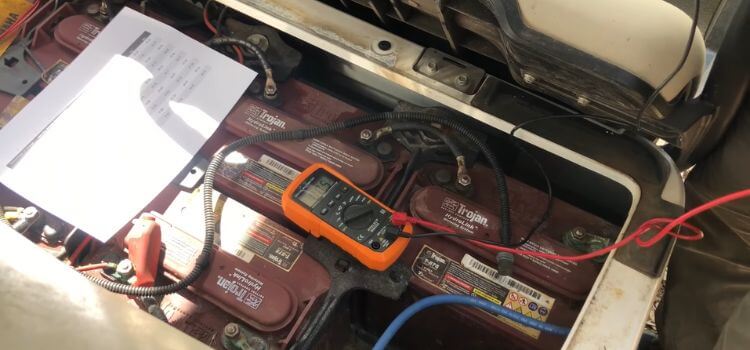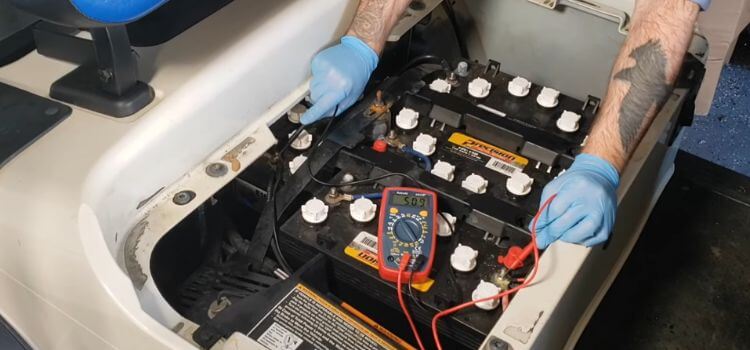As an Amazon Associate, I earn from qualifying purchases
To test golf cart batteries, use a multimeter to check the voltage, amperage, and load capacity, and visually inspect the cables, electrolyte level, and battery cleaning. Additionally, look for signs of dying batteries such as longer charging times, decreased power, and acid leakage.
Load testing is also a critical step to determine the overall health of the battery. To do this, put a load on the battery and measure the voltage drop – a healthy battery should maintain its voltage under load. If you don’t have a battery tester, you can use a voltmeter by touching its negative probe to the battery’s ground or negative terminal.
Methods Of Testing Golf Cart Batteries

To test golf cart batteries, use a digital multimeter or a battery load tester. Check voltage, amperage, and electrolyte levels, and clean the batteries regularly. Look for signs of decline, like longer charging time, decreased power, or acid leakage. Remember, proper testing ensures optimal performance and longevity of your golf cart batteries.
Testing the health of your golf cart batteries is crucial to ensure optimal performance and longevity. While using a multimeter is a popular method, there are other testing methods that provide more accurate results. In this section, we will explore three commonly used methods for testing golf cart batteries: Using a Multimeter, Load Testing, and Other Testing Methods.
Using A Multimeter
Using a multimeter is a simple and effective way to test the voltage of your golf cart batteries. Here’s a step-by-step guide on how to test your batteries using a multimeter:
- Turn off your golf cart and locate the battery compartment.
- Set your multimeter to the voltage setting and ensure it is properly calibrated.
- Touch the multimeter’s negative probe to the battery’s negative terminal and the positive probe to the positive terminal.
- Read the voltage displayed on the multimeter.
- A healthy golf cart battery should read around 12.6 to 12.8 volts. Any reading below 12 volts indicates a weak or faulty battery.
Load Testing
Load testing is a more accurate method of determining the overall health of your golf cart battery. It involves putting a load on the battery and measuring the voltage drop. Follow these steps to load test your golf cart batteries:
- Turn off your golf cart and connect a load tester to the battery.
- Apply a load to the battery for a specific amount of time (usually 15 seconds) and record the voltage.
- A healthy battery should maintain its voltage under load, while a weak or faulty battery will show a significant voltage drop.
- If the voltage drops below the recommended level, it’s time to replace your battery.
Other Testing Methods
In addition to using a multimeter and load testing, there are other testing methods that can help evaluate the condition of your golf cart batteries. These include:
- Specific Gravity Test: This test measures the density of the battery’s electrolyte using a hydrometer. A low specific gravity reading indicates a weak battery.
- Visual Inspection: Inspect the batteries for signs of leakage, corrosion, or bulging. These are all indicators of battery damage and should be addressed immediately.
- Professional Testing: If you’re unsure about performing the tests yourself, it’s best to consult a professional who has the necessary equipment and expertise to accurately assess the condition of your golf cart batteries.
By regularly testing your golf cart batteries using these methods, you can ensure that they are in optimal condition for maximum performance and longevity.
Step-by-step Guide To Testing Golf Cart Batteries

Testing golf cart batteries is an essential part of ensuring the optimal performance and longevity of your golf cart. By regularly testing the batteries, you can identify any potential issues and take the necessary steps to address them. Follow this step-by-step guide to effectively test your golf cart batteries:
Testing Battery Voltage With A Multimeter
One of the first steps in testing golf cart batteries is to measure their voltage using a multimeter. To do this, follow these steps:
- Turn off the ignition and all electrical components of the golf cart.
- Set the multimeter to the DC voltage setting.
- Touch the multimeter’s negative probe to the battery’s negative terminal.
- Touch the multimeter’s positive probe to the battery’s positive terminal.
- Read and record the voltage displayed on the multimeter.
Performing A Load Test
A load test is another important step in testing golf cart batteries as it helps determine the overall health of the batteries. Here’s how to perform a load test:
- Connect a load tester to the battery’s terminals.
- Activate the load tester and let it run for a predetermined amount of time.
- Observe the voltage drop on the load tester during the test.
- Compare the observed voltage drop with the battery manufacturer’s specifications.
Checking Electrolyte Level And Cleaning Batteries
Checking the electrolyte level and cleaning the batteries are crucial for their proper functioning. To do so, follow these steps:
- Inspect the battery cells and look for any signs of corrosion, leakage, or damage.
- If necessary, clean any dirt or corrosion from the battery terminals using a mixture of baking soda and water.
- Check the electrolyte level in each battery cell. Ensure that it is within the recommended range.
- If the electrolyte level is low, add distilled water to bring it up to the proper level.
By following these step-by-step instructions, you can effectively test your golf cart batteries, ensuring their optimal performance and extending their lifespan.
Frequently Asked Questions For How To Test Golf Cart Batteries
How Do I Know If My Golf Cart Batteries Are Bad?
To determine if your golf cart batteries are bad, look for these signs: longer charging times, quick power loss, decreased acceleration, and leaking acid or corrosion.
How Do You Check A Golf Cart Battery With A Multimeter?
To check a golf cart battery with a multimeter, follow these steps:
1. Set the multimeter to the voltage setting.
2. Connect the multimeter’s positive probe to the battery’s positive terminal.
3. Connect the multimeter’s negative probe to the battery’s negative terminal.
4. Read the voltage displayed on the multimeter.
5. Compare the voltage with the manufacturer’s recommended voltage range to determine the battery’s condition.
How Do You Check The Condition Of A Golf Cart Battery?
To check the condition of a golf cart battery, perform a load test by putting a load on the battery and measuring the voltage drop. A healthy battery will maintain its voltage under load, while a weak or faulty battery will show a significant voltage drop.
How Can I Test My Battery Without A Battery Tester?
To test your battery without a battery tester, follow these steps:
1. Start by checking if your golf cart battery is taking longer than normal to charge.
2. Pay attention to any decrease in acceleration or if your golf cart loses power quickly.
3. Look for signs of leakage, bulging, or corrosion on the batteries.
4. You can also use a multimeter to test the voltage drop of the battery under load.
5. If you suspect a weak or faulty battery, consult a professional for further testing.
Conclusion
To ensure your golf cart batteries are in optimal condition, it is important to regularly test them. By following the simple steps provided in this blog post, you can effectively test your golf cart batteries using a multimeter or a load tester.
Remember to check for signs of battery decline, such as longer charging times, decreased power and acceleration, and signs of leakage or corrosion. Regularly testing your golf cart batteries will help prolong their lifespan and ensure optimal performance on the course.
Keep your golf cart running smoothly by staying on top of battery maintenance.
As an Amazon Associate, I earn from qualifying purchases


